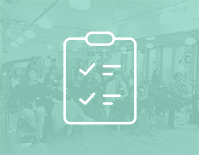How We Created a Notebook for Kickstarter Backers
One of our favorite parts of running the Kickstarter campaign for Present Yourself: The Book was designing the rewards for our backers. The book was going to take time to write and publish so we wanted something tangible to give backers early. That’s why we decided to create a companion notebook.

A notebook felt like an obvious choice. When you’re working through how you want to share your voice with the world, you need a place for your ideas. We put the encouragement we wanted to give to our community right on the cover: Someone needs to hear what you have to say.
How hard could it be to create a notebook? We thought it would be a quick, easy project. Oh, were we mistaken. Our plan was to get them printed and shipped within a month of the campaign closing. But, as with anything you do for the first time, there are unknowns and things weren’t as simple as they seemed.
Here are some of the lessons we learned creating the notebooks:
Finding a Printer
One of our main goals when we began creating the notebook was to work with a woman-owned (and, ideally, minority-owned) printer.
After a lot of google searching and asking our community for suggestions, we found a Baltimore-based printer who seemed perfect for the job. Working with them was wonderful, but the further we went along in the process, we realized we were difficult clients.
We had a vision of what we wanted to create. However, since we didn’t have experience creating notebooks, we didn’t do a great job communicating the details up front.
One challenge we faced was that no one on our team was local to Baltimore, so we couldn’t go in-person to see material samples. Proofs took extra time to receive because of shipping.
We also realized that the type of notebooks we had in mind were not something most local printers could easily accommodate. Adding in the qualities we were looking for became cost-prohibitive.
Since we didn’t start this process early enough, we had a set budget to work within as the Kickstarter had already launched. We decided that, above all, providing a quality notebook to our backers was what was most important. After a lot of effort to make it work with the printer we originally engaged, we ultimately turned to a larger manufacturer who could create the notebooks we wanted within the budget we had set.
If you’re keen on working with a certain vendor for a project of your own, don’t just talk to them early–confirm the details of the project early. That will allow you to build other things, like budget and timeline, around them. You’ll know what they’re capable of and what it will cost.
(We want to take a moment to thank the amazing folks at Alpha Graphics for being so communicative and accommodating. They were so patient with us and did their best to make things work within our price range. If you have any printing needs, we would recommend them.)
Unexpected Costs
Another lesson learned: custom notebooks are expensive! Even more expensive than we anticipated.
We knew the price of a notebook would vary based on elements like what paper we used, the cover stock, binding, etc. However, there are other costs that we hadn’t initially accounted for, including assembly, shipping, packaging to reship, and samples/proofs.
As we mentioned above, start early and ask a lot of questions about what it takes to create the product you want. Make key decisions around what the product will look like and how you’ll create it before committing to a price, and be prepared to make changes based on new information.
Timeline
When we planned our Kickstarter campaign, we wanted to have the notebooks created and shipped as soon as possible. Our hope was to have them out by the end of January. In reality, we weren’t able to ship them until the end of March.
First, we hadn’t confirmed a designer to create the cover until after the campaign started. We’re so grateful that we found someone who worked quickly within our timeline (thank you, Jessica!), but it did delay us from being able to confirm the final product with the printer, which wasn’t something we anticipated.
Then, when it came time to create the notebooks, we had a lot of decisions to work through. What kind of binding? What cover stock and finish? Did we want to include anything on the back cover or the spine? Where did we want the Women Talk Design logo?
Both the designer and the printer needed specifics that we hadn’t yet thought through. Going back and forth on the options took time, which was challenging while also running the campaign. Thankfully, they were able to work closely with us and provide ideas that we used to hone in on what was right for our project.
Our advice for working with vendors–whether on something digital like a design or physical like a notebook–is to have a good idea of what you want the final product to look like (and be able to provide examples from the get-go). Sometimes, it’s easier to know what you don’t want and be able to communicate that instead. Either way, the process will go more quickly if you have a place to start.
—
When you do something for the first time, there will be some unknowns. Everything we talked about above could have been helped by starting the process of creating the notebooks sooner. This advice might seem obvious but we were eager to make things happen on a tight timeline with a small team. We skipped a few steps.
In the end, we’re happy with what we’re able to deliver to our backers. And we know where to start the next time we’re creating a physical product. We hope you can learn from our experience and save yourself (and your vendors) some headaches!

